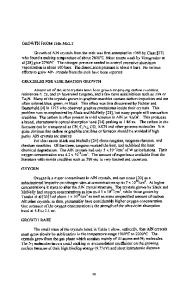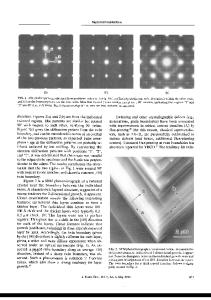Growth of Single Crystals of Mercuric Iodide (HgI 2 ) in Spacelab III
- PDF / 420,805 Bytes
- 6 Pages / 414.72 x 648 pts Page_size
- 13 Downloads / 326 Views
GROWTH OF SINGLE CRYSTALS OF MERCURIC IODIDE
(HgI2)
439 IN SPACELAB 1111,2
LODEWIJK VAN DEN BERG AND WAYNE F. SCMNEPPLE EG&G Energy Measurements Group, Santa Barbara Operations, Goleta, California, USA
130 Robin Hill Road,
ABSTRACT Continued development of a system designed to grow crystals by physical vapor transport in the environment of Spacelab III will be described, with special emphasis on simulation of expected space conditions, adjustment of crystal growth parameters, and on board observation and control of the experiment by crew members and ground personnel. A critical factor in the use of mercuric iodide for semiconductor detectors of x-rays and gamma-rays is the crystalline quality of the material. The twofold purpose of the Spacelab III experiment is therefore to grow single crystals with superior electronic properties as an indirect result of the greatly reduced gravity field during the growth, and to obtain data which will lead to improved understanding of the vapor transport mechanism The experiments planned to evaluate the space crystals, including gamma-ray diffractometry and measurements of stoichiometry, lattice dimensions, mechanical strength, luminescense, and detector performance will be discussed.
INTRODUCTION Single crystal sections of mercuric iodide (HgI 2 ) can be used as radiation sensitive elements in x-ray and gamma-ray detection systems. Because of the high atomic number of the constituent elements and the large electronic band gap of the material, the detectors are very efficient, can be operated at ambient temperatures and have low power requirements. These properties make mercuric iodide detectors suitable for use in, for example, x-ray fluorescence systems for elemental analysis and medical tomography instrumentation and for the observation of x- and gamma-ray sources in space from space platforms. The operation of solid state energy dispersive radiation detectors requires that the electronic charges created by the radiation are collected at electrodes on opposite surfaces of the detecting element. This implies, that the detector material should be of the highest possible quality, so that electrically active centers located within the band gap which can trap carriers during the time period of charge collection are minimized. One approach to reach this goal is to purify the crystal growing starting material to the extent possible and to adjust the stoichiometry in order to avoid native defects. In addition, however, it is also desirable to grow a crystal which is free of structural 5
This work was performed under the auspices of the U. S. Department of Energy under Contract No. DE-AC08-76NVO1183. NOTE: By acceptance of this article, the publisher and/or recipient acknowledges the U. S. Government's right to retain a nonexclusive royalty-free license in and to any copyright covering 2 this paper. Supported by NASA Contract No. H-34318B.
440 defects such as low angle grain boundaries, dislocation networks, localized twin structures and microscopic voids. This implies that th
Data Loading...











